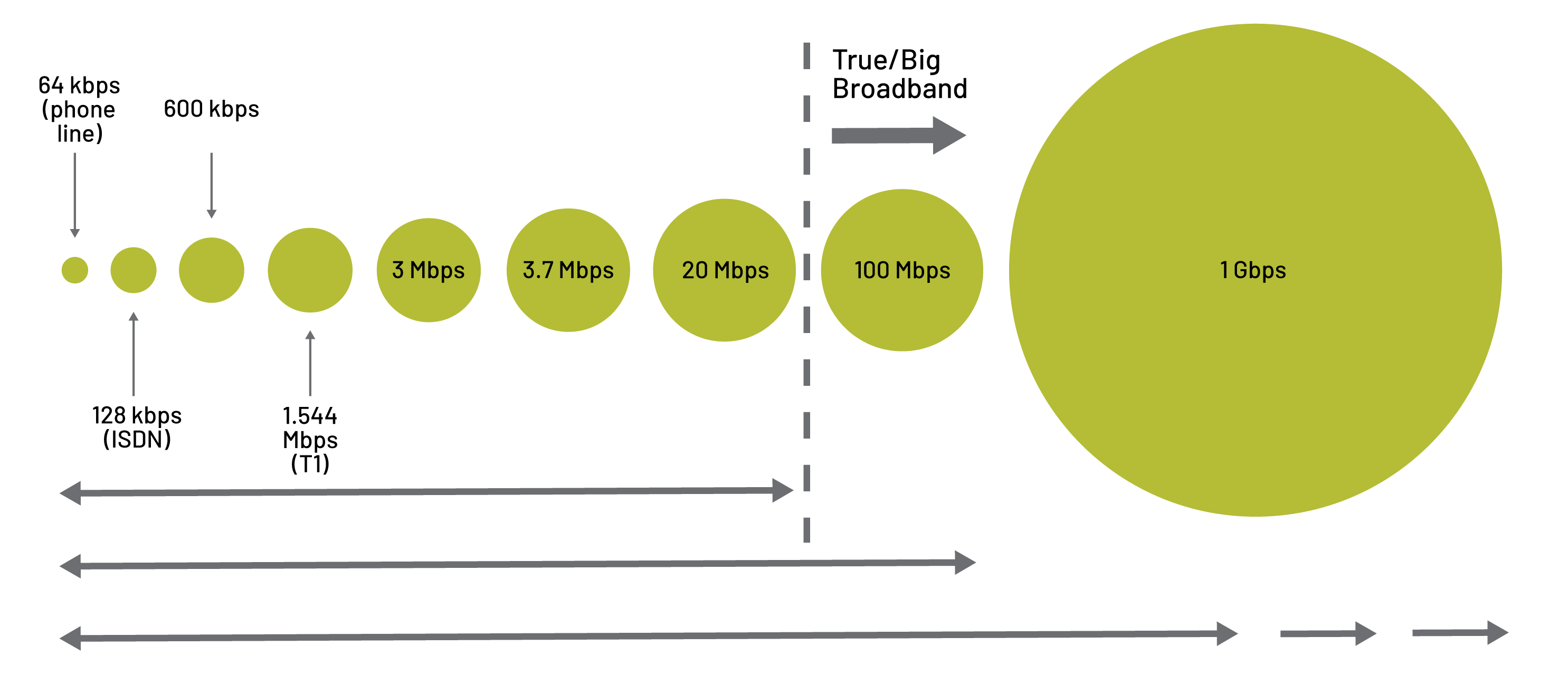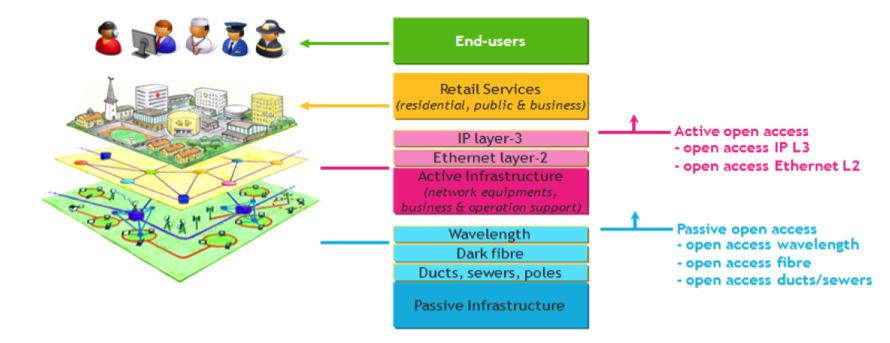Background
Broadband internet is generally defined as any high-speed internet access that is always on (as compared to dial-up access). The key word is “high-speed.” In Canada, the definition of high-speed changes over time, as the technologies and nature of the internet changes. For the context of this report, as of 2021, we will follow the CRTC definition of high-speed internet as meaning the ability to achieve at least 50 Mbps for downloads and 10 Mbps for uploads3.
Service Providers Overview
Global internet infrastructure comprises many independent but interconnected networks. Consumers connect to local or regional Internet Service Providers (ISPs) through access networks (called the ‘first or last mile’) that can be wireline (fibre optic or copper cables) or wireless (satellite or tower-based). Fibre-to-the-home or fibre-to-the-premise supports the highest internet bandwidth speeds (> 1 Gbps), as shown in Figure 1. Consumers purchase internet access from regional ISPs, who in turn acquire internet access from larger upstream ISPs (e.g. a Tier 1 network).

Figure 1. Carrying Capacities of Broadband Access Solutions (Adapted from Broadband Communities Magazine4).
Connections from a local access network to the global internet take place via a middle mile network. In the context of rural communities, the “middle mile” usually means the connection to a larger metropolitan centre. The Alberta SuperNet is one example of middle mile infrastructure. Backhaul networks then connect the middle mile to a major internet exchange or the core portion of a provider’s network. Middle mile and backhaul connections are almost always fibre-based, due to the large bandwidth requirements these connections must support.
The physical network infrastructure can provide broadband services according to a number of access models, based on who controls these various network layers:
- Physical Infrastructure Layer — copper, fibre optics, wireless radio (terrestrial or satellite)
- Network Provider Layer — active equipment such as routers and switches
- Service Provider Layer — internet services
Depending on whether one or more organizations control the above layers, different access models are used to deliver broadband services, leading to either infrastructure- or services-based competition.
Infrastructure-based competition means each service provider has to own and operate all layers of the network. In order to enter this market, a new service provider has to build its own network infrastructure.
In services-based competition, service providers leverage common physical infrastructure in order to deliver broadband services. This is predicated on open access networks that provide fair and non-discriminatory access to the underlying layer(s) for all service providers. This access would either be at the network provider or physical infrastructure layer (Figure 2).

Figure 2. Network layers and types of open access networks. Source: Fibre to the Home Council5.
Downloads vs Symmetric Bandwidth Speeds
While download speeds are the most commonly cited attribute reflecting broadband quality, access to symmetric bandwidth is becoming increasingly important. Symmetric bandwidth means the upload speed is as fast as the download speed.
Currently in Alberta, symmetric bandwidth is not the norm, as most commercial internet packages provide upload:download ratios ranging between 1:30 and 1:5. A number of newer fibre to the home (FTTH) services have symmetrical, or 1:1 ratio internet packages.
Significant changes in the data environment of individuals are putting more emphasis on upload speeds. These changes include the rapid increase of home videoconferencing services for both work and pleasure, especially after the start of the COVID-19 pandemic in 2020. The need for cloud storage of data, much of it higher quality image and video data created by mobile phones, is also pressuring upload speed requirements.
References
3CRTC. What you should know about Internet speeds. Accessed 14 December 2020.
4Broadband Communities Magazine. The FTTH Primer. Accessed 27 July 2016.
5Fibre to the Home Council Europe. FTTH Handbook - Edition 7. 16 February 2016.